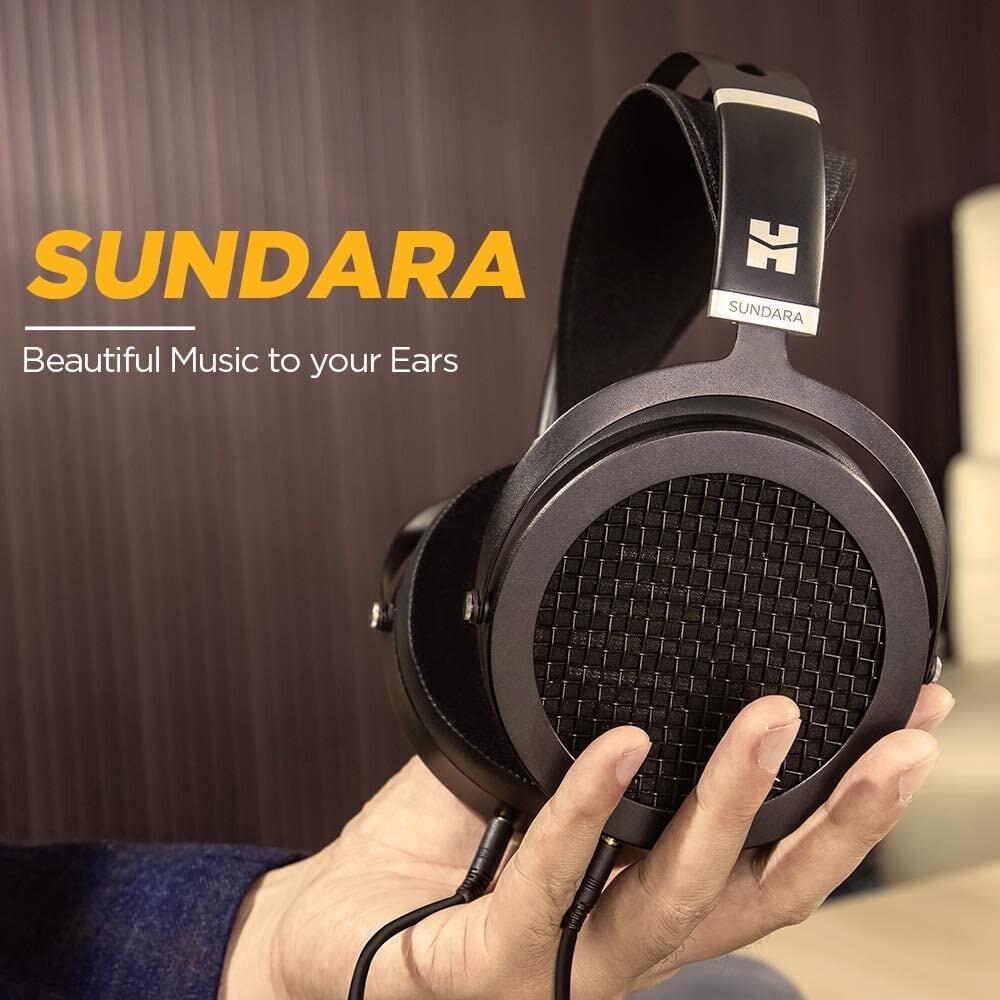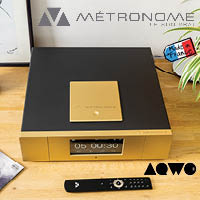HIFIMAN Sundara Headphones
I’ll start this review with a story. Since last year, I’ve experienced the following routine almost every morning. I wake up at five, and after the habitual espresso, I go straight to my audio setup and say hello to my turntable, CD player, speakers, and amp (like I imagine everyone does). Everything needed for me to begin my listening session, turn up my amp, speakers and enjoy. But, it’s too early. So, I compromise, I go for my phone and get the wireless headphones ready. There’s nothing wrong with this picture, of course, but after months of confinement, I felt my setup deserved more. Better sound, higher-end audio headphones and leave the wireless behind. Enter the audiophile headphone world.
My experience has always been with wireless over-the-ear headphones (Sennheiser PXC 550-II, Sony WH-1000XM3, Bose SoundLink—the Sennheiser’s are for me the clear winner of these three by the way). I had no need for wired headphones and the amp to drive them. I’ve had wireless headphones exclusively—some Apple AirPods Pro earphones as well because they are just so practical.
All the wireless headphones did their job, they were very good quality, nice looking, versatile, noise cancelling (closed-back headphones), and even some equalized with a phone application. Not dealing with cables was satisfying while outside, walking, jogging, or just for a trip to the coffee shop. But, what if I had traded audio quality for comfortable and pragmatic headphones? Sometimes they sounded flat (Bose), or they were too bright (Sennheiser) or I constantly got sound distortion (Sony). And, of course, I was constantly having to charge them. The most frustrating aspect though were the Bluetooth issues. The ones I owned kept losing their range at different distances. For my obsessive mind, this was just too frustrating. My wireless headphones had a lot to offer, but at the end of the day, I needed more, a new audio experience.
Researching for the entry-level audiophile headphones: Hifiman Sundara
As if I needed another reason for wired-headphones, this past year my wife and I, like many others, have worked from home. One of the few drawbacks, though, is we have a different schedule. As soon as I am off work, I want to listen to music. Because of this, loud volumes are rarely an option in my home. Listening to my ELAC Uni-Fi 2.0 Loudspeakers (review forthcoming) is impossible. My need for volume, better audio, and headphones reached its plateau.
Because of the pandemic, I couldn’t go out and patiently compared entry-level headphones. Ideally, this would be a long process of calmly surveying each headphone. There was no alternative but to read reviews, watch videos and trust my research.
My first question—how much do I want to spend? My budget was going to be $500 and perhaps go as high as $700. Certainly, there’s a market for high end headphones that cost thousands, but I wanted a good product to start. The plan was to begin reading about the subtleties of its sound: soundstage, imaging, noise isolation, accuracy, comfort, and go from there.
The top contenders on the list were: the Sennheiser HD 660-S, its cousin the HD650, and the Audio Technica ATH-AD2000X. Finally, it came down to two Hifiman headphones, the Ananda and the Sundara. After reading reviews, the difference between them was not substantial enough for me to buy the more expensive Ananda headphones. I decided to purchase the Hifiman Sundara headphones (Sanskrit for ‘Beautiful’), priced at $349. Aside from the consistent reviews regarding its build quality, they seemed to be the best option for the new sound I wanted. The Sundara’s are an over-the-ear, open-back planar magnetic headphone.
Sundara specs
Impedance: 37 ohms
Sensitivity: 94dB
Weight: 372g
Frequency response: 6Hz-75kHz
5 Ft 1/8 stereo cable.
Feel and Quality
The Sundara’s feel comfortable all around. Ear cups are not too tight on the ears, good clamp force with good cushioned pads. Its headband sits without strain on the top of your head, even after hours of use. The extension chasis can show signs of wear, scratching fairly quickly, so best to adjust them to the desired length and don’t move them. They are very light, very important for those Romantic symphonies that have no end in sight!
For this review I timed my tolerance with the Sundaras in one sitting, the clamp pressure tired me at about the 150 minute mark. They have a smooth, clean feel to them. Wires that connect to the cups are on an angle, so they don’t bother you (this was great for me because of my wireless experience). The only issue in the build (besides the cables, more on this below) is it's a pretty straightforward design. They don’t fold for a compact mode. Without any possible movement, like swivel of the cups, it’s pretty much an ‘as-is’ bulky headphone. The other aspect to consider is being an open-back planar, you will have sound leakage. So, best to keep them next to your setup where you can control the environment as opposed to having them connected to your phone outside.
When I first tried them on, there was a problem with the volume. The sound would slowly fade out on the left, then right, sometimes I’d have to jiggle the cables several times, then the sound would reappear. It was obvious the issue was the cables. I ordered some New Fantasia Replacement audio cables (10 ft cable $22.90 at Amazon) and since then, I’ve had absolutely no issues. If this was the only weak aspect of the build quality, I didn’t mind. The best was yet to come with the Sundara headphones.
The Sundaras are perhaps the best well-known and sought-after entry-level headphones on the market and after a couple of months, I understood why. Listening on my setup: Pro-ject DC Esprit SB Turntable with the Blue Ortofon stylus, my old faithful Sony Blu-ray player, and the PS Audio Sprout 100 Plus Integrated Amplifier, was a smooth experience. Driving these headphones was easy and fun.
Sound
I didn’t perceive a large, wide soundstage. The location of sound seemed more ‘focused’, ‘close’. I’ll describe it more as a ‘chamber orchestra’ than a ‘symphonic’ sound. This isn’t necessarily a bad thing. The strings, for example, sounded fuller—one can imagine the violins close to the cellos and violas in collaboration for a specific sound space. This, in contrast to a full-blown ‘heavy’ sound.
What made these headphones really shine is the outstanding separation and excellent timbral accuracy of the instruments. Specific location is not an issue with these headphones. What is created is a sort of a lively presence, an acoustic feel which is my preference. If you happen to enjoy chamber music—an intimate experience with the solo voice of an instrument—these will be right for you. I put on Narciso Yepes Albéniz & Granados (2017 Deutsche Grammophon CD) pieces and they felt alive and in wonderful sound.
I heard conflicting stories about the bass. Some said they were heavy, others, they were lacking; here’s what I found. The bass frequency is balanced; in fact, it’s very good for the music I listen to (mostly classical and jazz). They carry a nice sense of depth. The masterpiece Money Jungle (1963/2013 Wax Time LP) sounded just right, clean and full-bodied in Mingus’ phrasing and Roach’s rhythm.
Symphonic music also lit up with the Sundaras—I listened to Jochum’s Bruckner Eighth with the Staatskapelle Dresden (1979/2000 Warner CD) I was trying to capture what large space, panoramic sound Bruckner imagined. The Sundaras captured depth and space in between the brass and strings. I will mention however, I don’t listen to Hip-Hop or other genres that are bass-heavy; I can easily imagine the bass from these headphones will not blow your mind.
Treble accuracy measured well, with no excessive sibilance. It is on the brighter side, sometimes a little too much. When listening to Donizetti’s Lucia Di Lammermoor, with Joan Sutherland, Pavarotti and Bonynge with the Royal Opera House Orchestra (1972 Decca CD) or to Strauss’ Elektra with Inge Borkh and Fischer-Dieskau with Bohm and the Staatskapelle Dresden, (1961, Deutsche Grammophon LP) there were some arias the headphones didn’t respond well in the high tessituras. Volume had to be lowered, otherwise, they ‘stung’ my ears. This was my only ‘disagreement’ with the Sundara sound.
Saving the best for last. Midrange accuracy. What goes on in this spectrum is, as we know, where the nitty-gritty, more essential part of instruments and vocals are. The Sundaras are brilliant here, absolutely wonderful spacious sound. Easily the most accurate in this range. The low-midrange sound follows through, full, intense feel, and nicely textured timbres. For vocals it’s superb. I put on Berg’s Wozzeck, under Claudio Abbado and the Vienna Philharmonic (1988 Deutsche Grammophon CD). Franz Grundheber’s voice was filled with anxiety and the Sundara’s caught his angst nicely.
I tried some jazz guitar with Charlie Christian and the Benny Goodman Sextet and Orchestra (1935 Columbia LP) and big band sound for the mids. The presentation and detail were fantastic with the Sundaras. Wanting to get more perspective on the high-mid frequency, I went to Bill Frisell’s Blues Dream (1995 Nonesuch CD). The atmosphere of this album is mesmerizing. Here, the Sundara’s take in good air and dynamics and they found the necessary space for the guitars, rhythm section, and added horns in this great recording.
Final Thoughts
One of the big selling points in my research was they could be enjoyed and experienced without the need for an EQ amp. Even though next on my list, I wanted to start with a straight connection to my integrated amp. My research lasted a couple of months, and I can attest the Sundara headphones are the best fit for the beginner audio enthusiast. They are affordable and excellent value.
As such, the Sundara Headphones are neutral-sounding headphones, but so much more. Their accuracy and timbral accuracy will have you reaching for different genres to engage with. They are also fun. When clear imaging and an intimate soundstage are coupled with the music you love and listen to most, it’s a perfect match. I can recommend these headphones without hesitation.
Further information: HiFiman


























